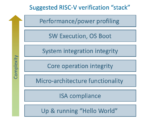-Reports of further tightening of China SemiCap Restrictions
-Likely closing loopholes & pushing back technology line
-Dutch have joined, Japan will too- So far no Chinese reaction
-SVB is toast but repercussions may be far worse
Reports of tightening semiconductor sanctions on Friday
It was reported byBloomberg of Friday that the Biden administration was further tightening restrictions on semiconductor equipment that can be sold to China.
It was also reported that the number of tools needing a license, which would likely not be granted , could double. And all of this could happen in a couple of short weeks by April 1st (no joke!)
If we take this at face value, we could take the impact previously reported by companies and basically double it. It could potentially be even worse as if the rules push the technology barrier further into past technology nodes, it is likely that both more customers as well as more equipment types will be covered by the sanctions.
Closing loopholes and work arounds
One of the issues with current sanctions is that there are some loopholes and work arounds that need to be stopped. It is not 100% clear that stopping EUV stops the Chinese at 14NM. With pitch splitting and multiple patterning and a number of unnatural acts and tricks you can coax some limited , low yielding wafers below prior limits.
This suggests that you have to push the limits back deeper into past technology nodes in order to reduce the ability to do a work around or other trick even if low yielding.
Our best guess is that this likely will push back a substantial portion of technology into the age of DUV and 193 immersion technology. On the lithography side, this is relatively clear but on metrology and dep and etch it will be a bit harder to define.
Concerns of re-labeling and altered specifications
One of our chief concerns about the sanctions is that much of the definition of what could and could not be sold rested with the equipment manufacturers.
Could an equipment manufacturer just re-label an existing tool or de-rate its true specifications in order to get an export license? Or better yet, just change the software to neuter the tool with the software fix to re-enable it being easy to implement or sell later. Tesla sells cars with the same battery pack that are software limited to reduced mileage but can be upgraded later through a software switch.
Metrology tools which have a higher software component than dep, etch or litho tools have had many different software options and “upgrades” available that enhanced performance with little to no change in the hardware.
We were concerned a bit by Applied saying that it had $2.5B of impact but said it was working to reduce the impact to only $1.5B by “working” with the customer. How exactly does that work? Could tools have be de-rated, re-labeled just have their specs reduced?
Just drop the hammer and restrict China to 8 inch tools
In our view, the easiest, simplest, most fool proof way of limiting technology is to limit tools sold to 8 inch (200MM) tool sets. That immediately pushes China back to 193 dry litho tools as ASML never made 8 inch immersion tools.
That would cause a relative hard stop at 90NM which would be hard to get around even with multiple patterning and pitch splitting.
Its pretty easy to tell a 200MM tool from a 300MM tool so harder to re-label or derate more advanced tools. Most of the fabs in China are 200MM anyway and most consumer applications can use that generation of device with smart phones and PCs being the exception. Older tools have been selling like hotcakes anyway as noted by Applied in their just reported quarter where 50% of business was non-leading edge (maybe not 8 inch).
China hasn’t responded to the October sanctions so tighten the screws further
We think one of the reason’s the administration is acting now is that there has been essentially no response from China to the October sanctions so why not go ahead and tighten them further given that there seemed to be little chance or ability to respond.
Its not like China has helped us out with the Ukraine/Russia issue and seems to be helping out Russia more, so why be nice. Of course it ratchets up Taiwan issues even further but its not like that has been improving in any event.
Will third parties exit China?
We can only imagine that some of the tightening is aimed at companies like Samsung, or SK or even Intel that have operations in China. The newer sanctions may restrict even more the ability to sell into non-Chinese semiconductor operations located in China.
We would also imagine that the administration has to make sure we don’t see “straw” buyers of tools or cross shipping from third countries. This could help push more fabs back to the US or maybe to India or Europe. These are all good things given the huge percentage of fabs and spend that have been concentrated in China over the last few years
The Dutch have joined the blockcade, Japan will follow suit
It was also announced last week that the Dutch have officially joined the blockade of China. Even though everyone instantly thinks of ASML, we would remind everyone that ASMI , the long lost father of ASML, makes critical ALD tools that are used in many advanced and multiple patterning applications. Adding them to the blockade makes things even more difficult.
Japan has already been doing a “soft” blockade by not trying to replace American tools not shipping to China. In our view its only a short matter of time before they officially join the bandwagon. At that point its all over. There will not be a lot that could be done to get around the three top makers of semiconductor tools all banding together. It would be decades, even with blatant rip-offs, copying and thefts before China could get even a fraction of the tools needed.
SVB- An old fashioned run on the bank in an internet app generation
The overnight implosion of Silicon Valley Bank overwhelmed the news about the new China sanctions, and for good reason. After reading through most of the information that has come out it appears that it is not a heck of a lot more than an old fashioned “run on the bank” or liquidity crisis. This is certainly not reassuring nor is it meant to be, in fact the probability of it happening to other banks is quite high and we have already seen at least one other bank, Signature Bank follow in the implosion of SVB.
Run on the bank
Banks obviously invest and lend out deposits such that only a small fraction of deposited cash is available at any one time for withdrawal and transfer. SVB with $200B plus in assets saw $42B in cash walk out the door in one day, Thursday (over 20% of deposits) such that they were negative $1B at end of day. There aren’t many banks today that could lose 20%+ of their assets in a single day and its amazing that SVB actually did.
This was essentially all depositor panic as the bank couldn’t liquidate assets fast enough to keep up and was forced to try to fire sale and sell stock as well to raise funds.
This was not because as some politicians said it was a tech bank or some sort of tech conspiracy. It was not like the S&L crisis of years ago where investments went bad and the bank simply did not have enough underlying money due to mismanagement. In the S&L crisis, depositors on got back 50 cents on the dollar of non-FDIC money. It is expected that SVB depositors will get 100% because the assets are actually there and worth something when properly, slowly liquidated.
The fed has said Sunday that everyone will get their money.
We would lay more of the blame with the velocity and “twitchiness” of money, and banking apps which is further amplified by lightning fast VC money and tech investors/depositors under pressure.
To unpack that statement we would first point to the fact that with internet apps and access we can move enormous amounts of money easily and without any friction for little more than a whim. With my phone I can move substantial money between multiple banks and brokerage firms without thinking. I don’t have to get in my car and drive down to the bank and wait in line. So the ability for a bank to lose 20% or more of deposits in one day has been enabled by technology ease.
Banks have been paying half a percent when I can and did move my money to get 4% or better elsewhere and it just took me a few clicks.
Secondarily, people have the attention span of a ferret on speed as well as the associated overly rapid reaction, weather to a real or perceived threat. When rumors of SVB started, it was transfer my money first, ask questions later.
There apparently were social media posts in the VC community about SVB issues. In addition Peter Thiel withdrew all his money just before the collapse. We are sure word of all this ran through the VC and tech community in the valley way faster than a wildfire and at internet speeds. This community runs at light speed anyway and obviously has the ability to move money at light speed. Tech has been both under pressure and concerned a lot about money of late which was further tinder for the wildfire and tsunami of money flow.
Basically some sparks started a hyper-speed chain reaction in an already stressed, twitchy, tech community that reacted too quickly for the bank to respond.
The result is SVB – “Silicon” Valley Bank is dead. SVB certainly did take risks and was not as diversified as other banks but that was not the root cause of the issue. Nor was it simple failed investments. They are not 100% clean either with rumors of last minute bonuses and insider stock sales.
SVB will leave a gaping hole in the valley. They did deals others wouldn’t touch. They earned a lot of fierce loyalty from tech companies that remembered who helped them when they were struggling. It is the loss of an icon and the name “Silicon” likely has special resonance for semiconductor related companies who started and still live in the valley. Its a knife in the heart of the tech industry.
But it could easily happen to other banks. Could Chase or Citibank tolerate an exodus of 20% of their depositors in one day? Chase has $3.6T in assets. Could they even come close to having $720B in assets fly out of their servers in the blink of an eye in a day? I very much doubt it. The fiberoptic cables linking them to other recipient banks would melt.
There are no laws or restrictions in existence today that would prevent a repeat of SVB and would prevent a lightspeed fueled, social media catalyzed run on a bank in an exposed sector.
SVB’s bigger issue is collateral damage
SVB is dead and soon to be buried. The FDIC will clean up the mess and bury the body and everybody will get on with business. But in the meantime there will be a parade of companies who are exposed to SVB who will put out press releases of how they are or aren’t impacted. Starting with half a billion at Roku. There will without doubt be a lot of chip and chip equipment companies exposed. We will probably live through a week of press releases and public assurances and telling people to remain calm.
It certainly just exposes how vulnerable things are.
The stocks
The thought of new China sanctions that could double the impact of the loss of China sales and should weigh on the stocks if anyone can get past the SVB news.
Its obviously highly negative for the entire semiconductor equipment group.
We have been saying for some time now that we were not at the bottom and there was still downside and this is yet another example of it.
And don’t forget….memory still sucks….
Add to the new China sanctions the SVB issue, which luckily happened in front of a weekend and you are setting up the upcoming week to look ugly and volatile despite all the well meaning assurances.
A couple of more Signature Banks or Rokus and it could get a lot uglier.
We won’t know the full extent of the fallout of either the new China sanctions nor the SVB fallout for some time. SVB will likely resolve more quickly as the fed has to quell panic. The new China sanctions will take some time to be announced then disseminated and analyzed. Its likely we won’t get an idea about the new impact on semiconductor equipment companies until they start to announce Q1 results in April.
As we have said for quite a while now, we remain highly cautious/negative on the group as a whole and feel that much of this news may cause the recent rally to reverse or at the very least slow. We had suggested that the rally was a dead cat bounce or false bottom and this is likely the evidence that supports that.
About Semiconductor Advisors LLC
Semiconductor Advisors is an RIA (a Registered Investment Advisor),
specializing in technology companies with particular emphasis on semiconductor and semiconductor equipment companies. We have been covering the space longer and been involved with more transactions than any other financial professional in the space. We provide research, consulting and advisory services on strategic and financial matters to both industry participants as well as investors. We offer expert, intelligent, balanced research and advice. Our opinions are very direct and honest and offer an unbiased view as compared to other sources.
Also Read:
Report from SPIE- EUV’s next 15 years- AMAT “Sculpta” braggadocio rollout
AMAT- Flat is better than down-Trailing tool strength offsets memory- backlog up
KLAC- Weak Guide-2023 will “drift down”-Not just memory weak, China & logic too
Hynix historic loss confirms memory meltdown-getting worse – AMD a bright spot









